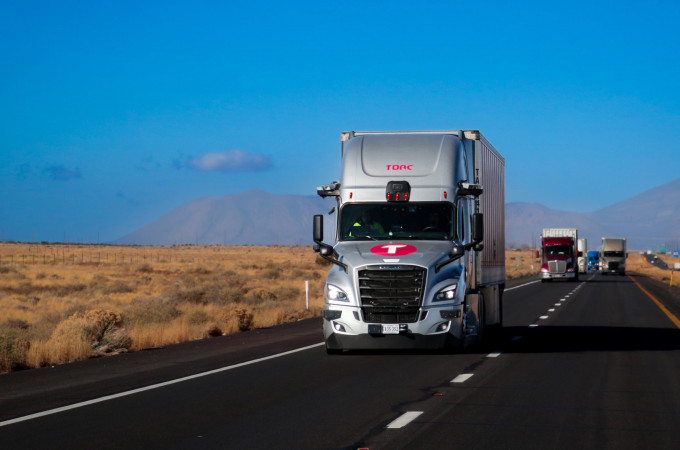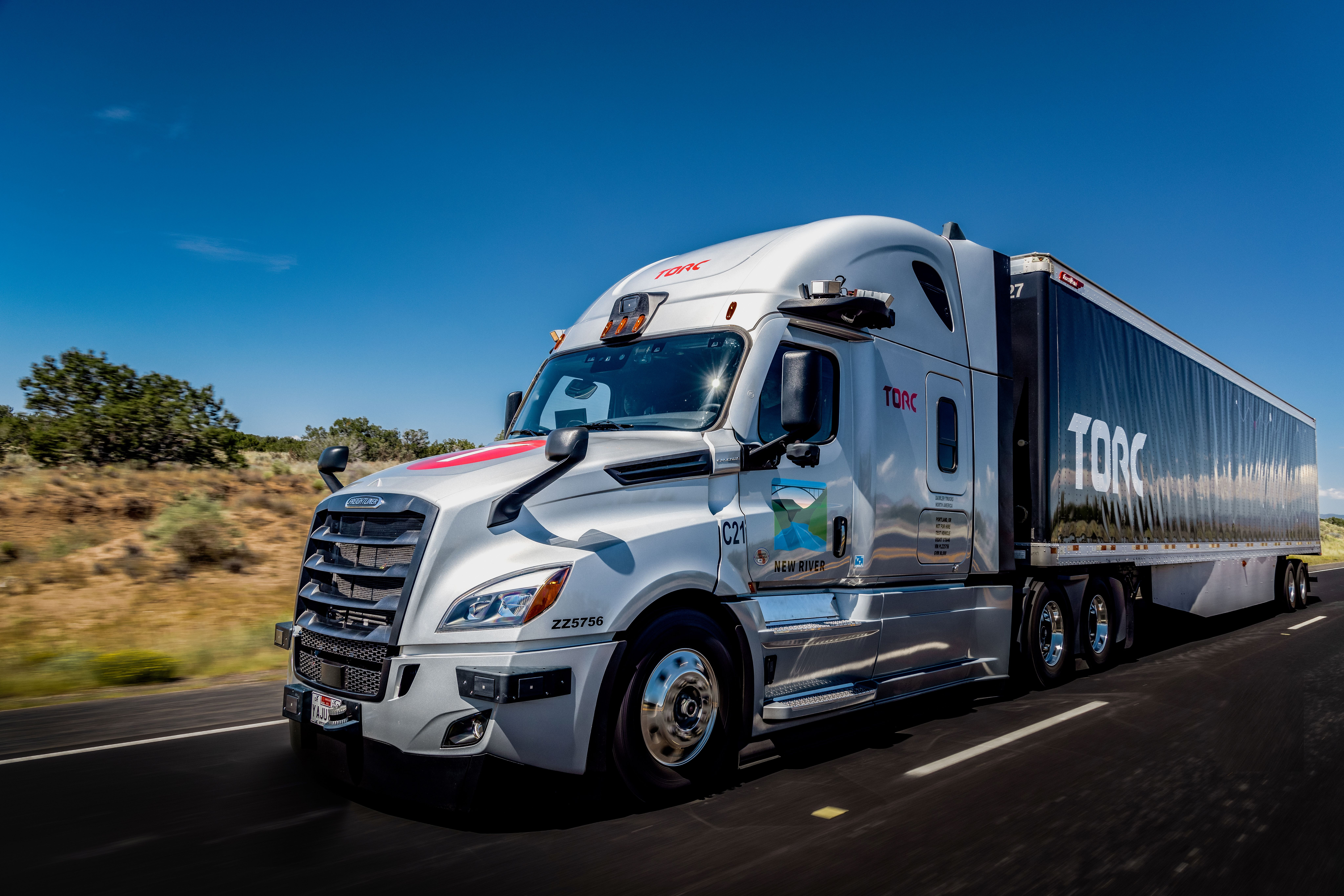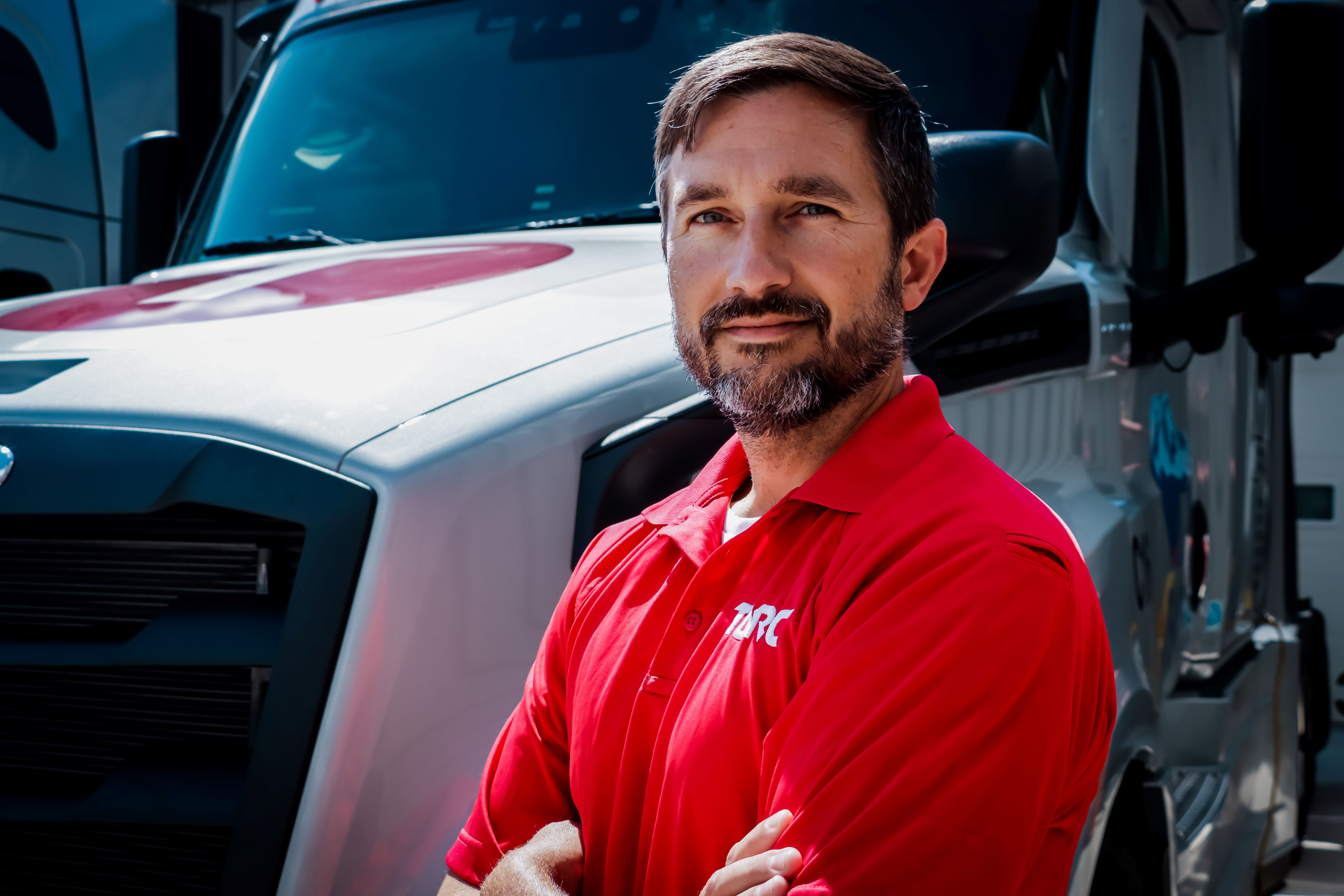A marathon, not a sprint: T&BB interviews Nick Elder of Torc Robotics
By Bradley Osborne - 25th July 2023

Freightliner truck with Torc autonomous tech on the road
USA – When one talks about autonomous vehicles, it is all too easy to slip into science-fiction reveries of driverless vehicles everywhere, transporting people and goods without requiring any human input. However, that is a vision of the future which is not shared by Nick Elder of American tech firm Torc Robotics. Routes that take goods vehicles through busy urban environments, or to multiple pickup and drop-off locations, handling cargo that requires more active monitoring, create variables that become incredibly difficult for artificial intelligence to handle safely and effectively. As far as these last mile applications are concerned, Elder believes that human drivers will remain essential for many years to come: “arguably, I would say, indefinitely”.
Long haul is a different matter. A set route between A and B, along with extensive stretches of straight roads and fairly predictable traffic mean that long distance applications employing Class 8 trucks could be automated with relative ease. It is for this reason that Daimler Truck North America acquired a majority stake in Torc in 2019 and set the company to work on developing trucks with Level 4 autonomy.
Even so, automating Class 8 trucks is easier said than done, and self-driving vehicles will not be desirable for every long haul operation. Torc’s engineers do not pretend to know the exact wants and needs of operators: as such, in 2022 it established an advisory council, made up logistics firms providing a broad swathe of different services who regularly meet to provide feedback to Torc. Through this forum of potential end customers, Torc intends to learn how and where its technology could be put to commercial use in the heavy truck segment.
The company’s view is that autonomous vehicle development is a marathon, not a sprint. It explains Torc’s slow and steady approach, which Elder characterises as “practical” and “realistic”; an approach which takes its direction from the truck industry rather than blue sky thinking. Torc’s outlook for self-driving vehicles is based on deep expertise. Though the commercial vehicle industry first began to take notice of Torc only after the Daimler Truck acquisition, in fact the company’s experience with working on autonomous vehicle technology goes back to the mid-2000s. In that time, Elder said, the target dates for launching self-driving vehicles on the road for commercial use have been repeatedly pushed back, and some of the earliest contenders have had to drop out of the race. Elder therefore recognises “just how challenging” it will be to not only create a reliable autonomous truck, but to also scale up production and maintain self-driving fleets on the road.
I was surprised when Elder described the work culture of Torc as “blue collar”. On reflection, however, I see why that label might fit. The picture put across to me is of a company with a “can do” attitude, tempered by hardheaded common sense and a respect for limits. Torc has always been based in Blacksburg, a largeish town in mountainous southwest Virginia which is dominated by Virginia Tech (“Virginia Polytechnic Institute and State University”), and Elder believes that this location has conferred some unique advantages. Being far away from Silicon Valley has, in Elder’s opinion, helped to keep Torc “humble”, fostering a work culture of “rolling up your sleeves, doing for the good of the team rather than looking for individual recognition”. Moreover, Blacksburg is much more the sort of place where somebody would want to settle down and raise a family than, say, San Francisco. Nevertheless, Torc recognised that the slower pace of Virginian life would not appeal to everybody, and hence it opened offices in Austin, Texas last year in a recruitment drive for more software developers.

Burruss Hall at Virginia Tech
From Virginia Tech to Daimler Truck
Torc traces its history back to the series of government funded competitions that are known collectively as the “DARPA Grand Challenge” – so called because its main sponsor is the Defense Advanced Research Projects Agency of the U.S. Department of Defense. Elder told T&BB that excessive casualties suffered by the military due to roadside improvised explosive devices (IEDs) originally motivated DARPA’s decision to set up the first Grand Challenge in 2004. It was thought that encouraging the development of autonomous vehicle technology could lead to a usable fleet of unmanned military vehicles, meaning that humans could be taken entirely out of certain logistics operations that carry significant risks to life. However, with the third competition, the so-called “Urban Challenge”, DARPA switched the focus to vehicles that could obey traffic laws and avoid other road users. In this competition, held in 2007, a team called “VictorTango”, with a Ford SUV retrofitted with self-driving technology, came in third place out of 53.
It was a team made up of current students at Virginia Tech and graduates who had founded the “Torc Robotics” company in 2005. With the newfound recognition gained from success at the DARPA Urban Challenge, Torc went on to work with various branches of the defence department to explore the uses of vehicle autonomy. Torc also partnered with Caterpillar Inc, who wanted to take human drivers out of potentially dangerous situations in the construction and mining sectors. These projects occupied Torc for over a decade, until about 2017, when technological developments enabled the company to grasp new opportunities. Advancements in sensor technology, computer performance, and artificial intelligence encouraged Torc to look beyond the niche applications it had concerned itself with up until that date. Talks were begun with Daimler Truck, leading to the acquisition of a majority stake in Torc in 2019.
Today, Torc enjoys the backing of a multinational corporation which owns several truck brands in Europe, North America, and Asia. But Elder insisted that Torc fared well enough before the acquisition, making its living and slowly growing through its project involvements with the U.S. government and Caterpillar. Until 2019, Torc “had never taken any outside capital”, Elder said. And while he admits that the financial security is a huge boon to the company, Elder would not say that this was the main advantage of the relationship with Daimler Truck. Rather, he pointed to the German manufacturer’s extensive knowledge of and involvement in the truck segment as the primary reason for the relationship. In order to get to the “deep level of integration” with the chassis and the self-driving tech that Torc was aiming for, it was inevitable that the company would need a “strong partner” from the truck industry. Only by working closely with the OEM – in particular, with Daimler Truck’s ‘Freightliner’ brand – does Torc feel it can achieve a “viable, serviceable, scalable long term product”.
One might think that an AI-driver could be made to work in any type of vehicle. However, in Torc’s experience, developing a self-driving truck presents different challenges to those of an unmanned defence or mining vehicle. The principles are the same: the vehicle must be able to perceive its environment, identify obstacles and other road users, and take appropriate action to navigate safely. But the hardware and software requirements can change significantly, depending on the vehicle type, the application, and the environment. The viewing range and stopping distance required for a Class 8 truck travelling at highway speeds are different from those required for an urban robotaxi, for example. As such, the knowledge gained from working with Daimler Truck, together with the feedback from the advisory council have helped to flatten the learning curve for Torc.

Side-on view of autonomous test truck
The future of Torc and autonomous driving
When asked about the challenges which companies face in bringing a viable self-driving truck to market, Elder pointed to existing gaps in hardware technology and availability. In particular, off-the-shelf radar and lidar products that can meet the needs of autonomous vehicles are not yet available. Elder said that there are “ultra long range” lidar products that are currently in development, but it will be some time before these are available at scale. Not to mention, more time will be needed to integrate this hardware with Torc’s software.
An area of strength for Torc is vision-based perception, using cameras mounted all around the truck. This was bolstered by the recent acquisition of Algolux, a tech firm based in Montreal. Another area of expertise which Algolux is contributing is machine learning, helping Torc’s software to quickly identify and handle risky driving scenarios in real time. The cameras, however, will need to work in concert with radar and lidar to give the self-driving truck enough accurate information to make safe and intelligent choices. Putting together all the autonomous driving components into a single production package will be a collaborative effort between Torc and Daimler Truck.
When Torc started out in the mid-2000s, the motivation behind the development of autonomous vehicles was to save lives. In the truck sector, making safer vehicles is a worthy cause, and as such it is a priority of governments across the developed world. An unmanned truck which is not liable to human error – that is to say, the foibles of an inattentive or incautious driver – could dramatically reduce the risk of accident and therefore help to make the road safer for others. But Elder admits that the conversation has shifted in recent years. Promoters of self-driving trucks talk less about safety and more about total cost of ownership. Elder thinks this is “fair”: there are widespread shortages of human drivers, and in any case, a self-driving truck has the potential to overcome some of the obvious physical limitations which humans cannot. A self-driving truck does not need to sleep or take a toilet break. Theoretically, an operator could put one to use all hours, needing only to stop for maintenance or refuelling. The economic benefits of maximising the use of an expensive asset like this are apparent.
That is not to say that considerations of safety have fallen by the wayside. On the contrary, Elder insisted that Torc is committed to testing every component of its self-driving technology with “rigour” until it is assured that it has a product that it can release “out into the world” with confidence. The early days of the DARPA Grand Challenge and the hype over autonomous vehicles are in the past for Torc. Now the dust has settled somewhat following the first excitement, Elder feels that the autonomous vehicle sector is entering its maturation phase – during which, tech firms such as Torc will for the first time be able to offer commercially viable tools that are more than just demonstration vehicles. The word “tool” is key: the self-driving truck will be another instrument that will complement, not replace, the tools which are already at the operator’s disposal. Torc’s goal is not to “revolutionise” or “disrupt” long distance trucking, but to make a tool which is as reliable and as useful as possible to the industry. And so, we return to self-image of Torc as a tech firm with a blue collar ethic of diligence and common sense, so far removed from the visionary ideas of Silicon Valley. In the end, the slow and steady approach might put Torc in first place.

Nick Elder is Director of Corporate Strategy at Torc Robotics, leading development and commercialisation of the company’s long-haul autonomous technology. He has served in several leadership roles over the past eight years, including running its Mining and Construction unit.


